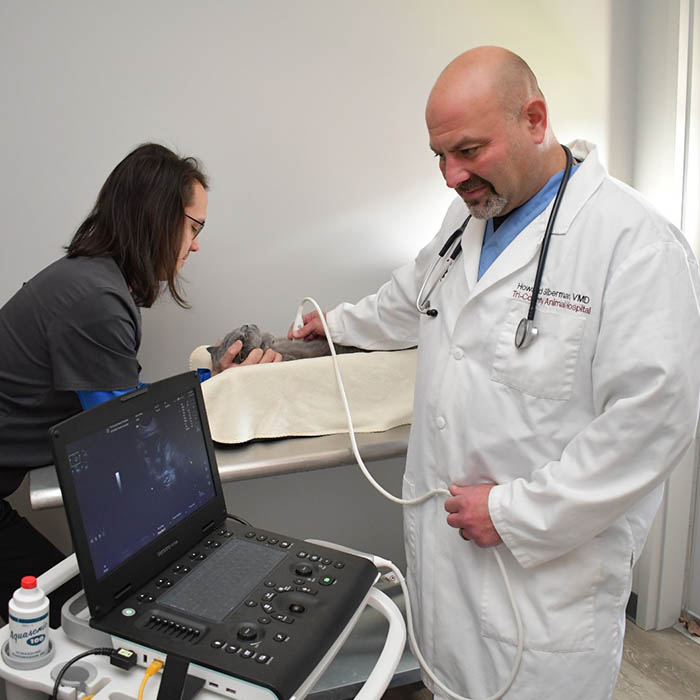The Duty of Ultrasound and CT Scan in Modern Vet Practices: Insights From Experienced Professionals
In contemporary veterinary techniques, ultrasound and CT scans significantly boost diagnostic capabilities. These imaging techniques offer vital understandings right into animal wellness, directing therapy decisions. Experienced professionals identify the unique benefits of each method. Ultrasound uses real-time evaluations, while CT checks supply elaborate anatomical details. Comprehending their duties and applications elevates essential questions concerning their influence on patient outcomes and the future of veterinary diagnostics. What understandings can be obtained from their combined usage?
Comprehending Ultrasound in Vet Medication
Ultrasound is a crucial diagnostic device in veterinary medicine, using a non-invasive approach to visualize inner frameworks. This imaging strategy uses high-frequency acoustic waves to develop real-time photos of cells and body organs, enabling vets to evaluate conditions without surgical treatment. Common applications consist of evaluating the heart, liver, kidneys, and reproductive body organs, in addition to checking pregnancies.The treatment is fairly fast and can be performed in numerous settings, making it an easily accessible alternative for veterinarians. Unlike radiography, ultrasound offers comprehensive details regarding soft cells and blood flow, which is vital for accurate diagnoses.Veterinary professionals count on ultrasound to spot abnormalities such as growths, cysts, and liquid build-up. Its capacity to guide biopsies and other procedures additionally improves its energy in clinical practice. By supplying a reliable and secure means to examine internal composition, ultrasound has ended up being a keystone of modern vet diagnostics.
The Advantages of CT Scans for Animal Diagnostics
CT checks offer substantial benefits in vet diagnostics by offering improved accuracy in determining interior problems (CT Scans For Animals). As a non-invasive imaging strategy, they guarantee the safety and security and convenience of animals throughout evaluations. On top of that, CT scans assist in an extensive evaluation of internal structures, enabling for more effective therapy planning
Boosted Analysis Accuracy
Developments in imaging technology have considerably enhanced analysis precision in vet medication, especially through making use of CT scans. These scans supply in-depth cross-sectional images of an animal's interior frameworks, enabling vets to identify problems with precision. The high resolution and three-dimensional abilities of CT imaging help with the detection of problems such as lumps, cracks, and interior bleeding that might be missed with standard imaging approaches. Additionally, CT scans can assist in pre-surgical planning by providing a detailed sight of anatomical relationships. This level of information not just boosts the precision of diagnoses yet additionally aids in customizing reliable treatment plans. Consequently, the combination of CT innovation right into vet practices is changing the landscape of pet medical care, improving results for people.
Non-Invasive Imaging Technique
The intro of non-invasive imaging techniques has reinvented pet diagnostics, with CT checks becoming a popular device in vet techniques. These scans offer high-resolution, cross-sectional pictures of a pet's internal structures, permitting vets to assess intricate problems without the requirement for intrusive procedures. The advantages of CT scans include their capacity to discover tumors, fractures, and inner bleeding with impressive accuracy. Additionally, they facilitate the assessment of soft cells and organs, enhancing analysis capacities. The rate of CT scanning makes it possible for fast decision-making, which is crucial in emergency situation circumstances. By decreasing stress and discomfort for the pet, CT scans add to a much more gentle technique to diagnostics, inevitably improving treatment end results and progressing vet care.
Comprehensive Internal Analysis
A detailed internal assessment is essential for exact diagnosis and effective therapy in vet medication. CT checks deal considerable advantages in this regard, supplying detailed cross-sectional photos of a pet's inner structures. This advanced imaging method boosts visualization of complex anatomical areas, allowing veterinarians to recognize irregularities such as growths, fractures, and interior blood loss with greater precision. In enhancement, CT checks help with the assessment of conditions that may be testing to identify through traditional approaches. The speed and precision of CT imaging additionally contribute to prompt treatments, enhancing person end results. As veterinary practices progressively incorporate CT modern technology, the advantages of comprehensive internal analyses become obvious, enhancing the importance of this device in contemporary veterinary diagnostics.
Comparing Ultrasound and CT Imaging Techniques
While both ultrasound and CT imaging serve important roles in vet diagnostics, each technique uses distinctive benefits and limitations that can affect clinical decision-making. Ultrasound is especially valued for its real-time imaging capabilities, allowing vets to observe dynamic physiological processes. This method is non-invasive, mobile, and does not entail ionizing radiation, making it a much safer option for both animals and medical professionals. However, ultrasound might have limitations in envisioning certain anatomical structures or deep tissues.Conversely, CT imaging gives thorough cross-sectional views of the body, allowing for specific localization of problems. It succeeds in evaluating complicated body organs and frameworks, specifically in the thorax and abdomen. CT scans need sedation or anesthesia in numerous cases and entail direct exposure to ionizing radiation. Ultimately, the selection between ultrasound and CT relies on the details scientific circumstance, the area of rate of interest, and the urgency of the diagnostic needs.
Situation Researches: Successful Medical Diagnoses Through Imaging
Study illustrate the substantial renovations in analysis precision attained through sophisticated imaging technologies like ultrasound and CT scans in veterinary methods. These innovations not only improve the detection of different problems yet also promote reliable and prompt treatment plans. Examining specific cases can highlight the transformative influence of these imaging techniques on veterinary medication.
Analysis Precision Improvements

Imaging Modern Technology Advancements
As veterinary imaging technology continues to develop, its influence on analysis from this source capacities comes to be significantly apparent. Recent study highlight the successful application of advanced ultrasound and CT scan techniques in identifying complex conditions. For instance, a vet clinic utilized high-resolution CT scans to diagnose an uncommon kind of lung cancer cells in a dog, which standard imaging had actually missed out on. Likewise, an ultrasound evaluation disclosed a stomach mass in a pet cat, triggering timely surgical treatment and a favorable outcome. These developments not just boost diagnostic accuracy but also make it possible for vets to design targeted therapy strategies. By leveraging advanced imaging technologies, veterinary professionals are substantially improving patient treatment, causing extra reliable administration of numerous wellness conditions in pets.
The Role of Imaging in Emergency Veterinary Care
Imaging plays a vital role in emergency vet care, supplying veterinarians with vital info required to make rapid, educated decisions. In urgent circumstances, strategies like ultrasound and CT scans enable experts to rapidly analyze an animal's interior frameworks, identifying essential conditions such as internal blood loss, cracks, or organ irregularities. These imaging modalities allow for real-time assessments, promoting timely treatments that can be life-saving. As an example, ultrasound is very useful for assessing soft cells injuries and conditions like fluid buildup, while CT checks offer thorough pictures of complex anatomical structures, essential for diagnosing trauma situations. The rate and precision of these imaging methods enhance the veterinarian's capability to create reliable treatment plans, guaranteeing the very best feasible results for their individuals. Consequently, the combination of sophisticated imaging innovations into emergency situation veterinary techniques is not only helpful however significantly required, as it enhances diagnostic capacities and boosts total animal care during vital minutes.
Training and Experience in Veterinary Imaging
Sophisticated imaging methods such as ultrasound and CT scans are vital for reliable veterinary care, the successful application of these technologies greatly depends on the training and competence of veterinary specialists. Proficient usage of imaging devices needs detailed knowledge of composition, pathology, and the concepts underlying each modality. Veterinary experts have to my link undergo customized training to properly interpret imaging results, which is important for detecting problems and intending treatment.Certifications and continuing education in vet imaging boost the skills of professionals, enabling them to stay upgraded with technical advancements. Partnership in between vets and radiologists commonly leads to improved diagnostic precision, as professionals can supply understandings right into complex situations. On top of that, sensible experience in dealing with imaging equipment cultivates self-confidence in its application. Inevitably, the quality of vet imaging services is directly associated to the level of training and competence had by the professionals making use of these necessary diagnostic devices.
Future Fads in Diagnostic Imaging for Animals
With the quick improvements in innovation, vet analysis imaging is positioned for considerable evolution in the coming years. Emerging trends indicate a shift towards even more available and portable imaging modalities, such as portable ultrasound devices, which could improve field diagnostics. Furthermore, the combination of synthetic intelligence is anticipated to transform picture evaluation, enabling quicker and a lot more accurate interpretations of results.Moreover, developments in 3D imaging techniques and computed tomography will offer veterinarians with more complete views of animal anatomy, resulting in enhanced treatment strategies. Virtual fact technology might likewise contribute in surgical planning and education, offering vets an unique point of view on intricate cases.As telemedicine remains to grow, remote appointments assisted in by analysis imaging will become extra usual, enabling professionals to help basic professionals in real-time. Generally, these trends are set to improve the efficiency and efficiency of veterinary treatment, inevitably boosting pet end results.
Regularly Asked Concerns
Just How Much Do Ultrasound and CT Scans Cost in Vet Facilities?
The expenses of ultrasound and CT scans in vet centers typically vary from $300 to $1,500, depending upon elements such as area, center type, and particular treatments needed for the pet's diagnosis and treatment.

Are There Any Type Of Risks Connected With Ultrasound and CT Checks for Pets?
Ultrasound and CT scans typically present very little risks to animals. However, potential worries include sedation responses and exposure to anesthetics. CT Scans For Dogs. Veterinarians very carefully analyze each instance to mitigate any threats connected with these diagnostic treatments
How Much Time Do Ultrasound and CT Treatments Commonly Take?
Ultrasound treatments normally take around thirty minutes to an hour, depending upon the intricacy. CT scans, being more detailed, usually call for half an hour to 90 minutes, consisting of prep work and healing time for the animal.
Can All Veterinarians Perform Ultrasounds and CT Scans?
Not all vets can perform ultrasounds and CT scans. Specialized training and certification are usually needed to assure competency in these innovative imaging strategies, which might limit their availability to vets with additional certifications and sources.
What Types of Pets Profit The Majority Of From These Imaging Techniques?
Particular animal types, especially pet cats and dogs, benefit considerably from ultrasound and CT scans. These imaging strategies boost analysis precision for problems like tumors, inner injuries, and body organ irregularities, bring about enhanced therapy results and client treatment. The high resolution and three-dimensional capacities of CT imaging facilitate the detection of conditions such as lumps, fractures, and interior blood loss that could be missed with conventional imaging approaches. Case research studies show the considerable enhancements in diagnostic precision achieved via innovative imaging technologies like ultrasound and CT scans in veterinary practices. Improving analysis precision in vet practices has actually been substantially assisted by innovations in imaging innovations such as ultrasound and CT scans. Innovative imaging strategies such as ultrasound and CT scans are crucial for effective vet care, the successful implementation of these innovations heavily depends on the training and knowledge of vet experts. Veterinary specialists need to undergo customized training to precisely analyze imaging outcomes, which is important for detecting conditions and planning treatment.Certifications and continuing education and learning in veterinary imaging boost the abilities of professionals, allowing them to remain upgraded with technical advancements.
Comments on “FAQs About Visiting a Cancer Veterinary Near Me}”